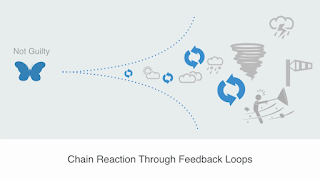New Study & Training Program on Risk Management & Sustainability
TankTerminalTraining in cooperation with Creazene.org
offer a new training program based on research about causality of Risk and
Sustainability in the energy sector. It shows that 79% of risks can be
contributed to human decision making. The other 21% of risks are caused by non
human influence such as weather, floods, volcanoes, drought, earth quakes, etc.
Once we understood this, says Arend van Campen, leader
of the research team, we then looked at decision makers’ awareness, motivation
and if they were able to understand their company or organisation as a living
organism. Also an important question was if they were approaching Risk and
Sustainability from a mechanistic or reductionist position or from deontological
motivation, their duty.
This was needed, because rational, mechanistic
thinking usually only understands and deals with linear causality (direct
effect), but have sometimes difficulty to understand non linear causality (indirect
and unpredictable effect).
The latter is the case. Because risk management is
often seen as a tool that is to be applied after
a risk is recognised, such as compliance to regulations, adherence to laws or covered
by some form of ISO standard, decision makers are still often unaware of a
manner to prevent risks by understanding them being systemic, interrelated, interconnected
and interdependent and therefore preventable and controllable.
The research team used Systems Science to determine
that decisions were often not made by looking at the whole, but rather were
made by looking at parts.
Our question was why and we came up with a tool, copied
from nature we now call ‘Risk Contemplation
Tool (RCT)’, which works exactly as nature does. Nature is reality. Nature does not choose sides, it has no motivation or
purpose, at least not for the time being, than to create and support life.
Businesses however do not always think like this.
Their motivation sometimes does not place life or sustainability as a priority,
but aim for profit, economic growth, success or financial gain. Such motivations
are in themselves not harmful, but can become that because these usually do not
take into account possible negative effects on the entire network of
relationships of which they too are a part.
For example; a mining company buys a copper mine in
Africa, but to expand the mine, local communities are coerced to move from
their ancestral lands. The Mexican Gulf Macondo disaster was caused because of
haste. Enron, already a while back, imploded because managers were making
decisions only on that information which would confirm growth. Volkswagen will
be paying billions in fines and buy backs, because they tried go beyond
reality. Fracking causes uncontrollable volatile effects, and so on. Examples
of such costly effects are: paying expensive compliance and legal teams, exposure
to law suits, reputation damage, tarnishing of a brand, etc.
A very simple scientific fact is: ‘we
cannot control nature, we only disturb it.’ Reality is real. Nature deals
with what is real and will react on everything what is not real or disturbing it
in an uncontrollable, unpredictable manner.
Nature works as follows:
•
Maximum
Efficiency
•
Minimal
Energy
•
Principle
of Maximum Grace
•
Intricate
order
•
Multiplicity
in Unity – Emergent Properties
•
Maximum
Coherence to the whole
Telling untrue facts about a product or service, directly causes
vulnerability and imbalance resulting in overwhelming outcomes: for example: personal
remorse which cannot be ‘switched off’ and societal distrust.
Simply put, we can benefit of using this inescapable
reality in nature to create a thorough and preventive Risk Management System:
1. Allow
and use all (as much as you can) information to base decisions upon. This
information is called: feedback.
2. There
are two types of feedback; positive (amplifying) and negative (dampening).
Positive feedback (information which confirms purpose such as more profit, more
success, growth) needs to be corrected, slowed down (dampened) and balanced
with information such as warning, caution, awareness of limits in growth
through one of our innate survival mechanisms: our conscience.
3. They
form so-called ‘feedback loops’ which can be used as a cybernetic steering
mechanism.
4. To
avoid or prevent risks, we can direct our organization, just like a helmsman
does, to stay on course within natural boundaries of functionality (natural
law). This means always within natural environmental and planetary limitations.
This ‘risk contemplation tool’ or (RCT) which
organisations could implement is that if they do not constantly correct course
and balance decisions on the acceptance of ‘all’ information, including
‘inconvenient’ information, many case studies prove that any process without
the adjusted balance of feedback loops becomes unsustainable. If it does not
allow this steering principle, a direct consequence, confirmed by mathematics,
physics, ecology, biology and systems science, is that the whole organisation
will become instable as it enters a realm of non-linearity, also known as Chaos
Theory or Butterfly Effect

RCT could therefore become the control and sustenance
tool of preference and could replace many rules, regulations or laws which in
fact impair an organization’s functioning. Rules and regulations can become
‘guidelines’.
When a board of directors or management team finds
itself in a compromising position which would ask of them to pursue the
allowance of positive feedback only in order to achieve a pre-set goal, they
immediately are warned by RCT that the outcome of such a goal or purpose will
be unsustainable. The pre-set goal could be beyond nature’s and environmental allowance
to condone it.
If we ignore RCT as we have done since the time of
mechanistic thinking separated our minds from our bodies (body-mind duality)
about three-hundred years ago, our planet will not allow motivated decision
making by positive feedback alone much longer. The conditions supporting life
have for a great part already been destroyed by ignoring negative, but
correcting feedback. Such is the law of nature. We are a part of nature and
have the ability (choice) to navigate our vessel back into safer waters or be
shipwrecked.
Linear Effects change into Non Linear Effects
Conclusion
79 % of global risks are caused by a human tendency to
only use preferred information which confirm purpose.
Gregory Bateson, once of the first Cyberneticists once
said: ‘The major problem in the world are the result of the difference between
how nature works and the way people think.’
To understand what this could can be explained by this
example from the Tank Terminal Storage Industry:
When an oil storage terminal is asked to store and
blend fuels of which it knows they could have harmful effects on people and
environment of countries that would import and use them, their management can
use the RCT to investigate potential non-linear effects in cooperation with the
energy company it rents the storage tanks to. RCT can be used to verify if (all
information), positive and negative feedback, will be accepted and kept in
balance. If not, then a deal should not be made, because uncontrollable effects
will destabilize the businesses of both parties. This is an inescapable
scientific fact. The next step then would be to suspend and phase out the
production and distribution of harmful fuels and replacing them by clean fuels.
RCT could be applied to any business, industry or political process. It asks:
could my organization have damaging non-linear effects on human and non-human
life, the environment and social cohesion? It the answer is no, proceed, if
yes, adjust the process.
A long term
vision
The value of RCT is that anyone in any business or
politics does not have to feel pressured or be anxious any longer. A manager
can use RCT as a sufficient natural reason and economically sound excuse to
negotiate mutually beneficial deals without the fear of competitive economic
disadvantage. With this tool in mind managers will always be looking for
sustainability in line with what nature demands. Managers understand it will be
in their best interest and reputationally beneficial. This leads to personal
health improvement, reduces stress and anxiety, enhances safety levels and
ensures environmental protection. A win-win situation.
This study could be regarded as that negative feedback
loop which would help restore the economic and natural equilibrium. It is quite
easy, don’t ignore it and just mimic nature.
Arend van Campen, MA
TankTerminalTraining





Reacties
Een reactie posten